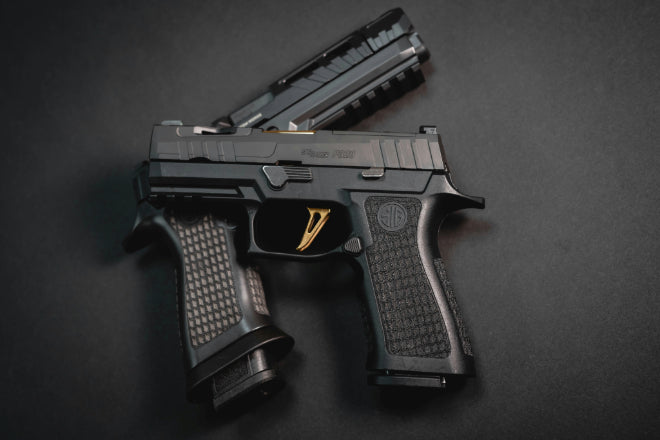Choosing the right gun cleaning mat can be surprisingly confusing. Walk into a store or browse online, and you’ll see mats that look almost identical but range from a few dollars to premium models with diagrams, padding, and magnetic trays. Some gun owners buy the cheapest option only to watch it crumble after a couple of uses. Others spend too much on features they never actually need.
The truth is, the best gun cleaning mat isn’t about the brand or the price tag alone; it’s about how well it fits your routine, your firearms, and your workspace. A mat that’s perfect for a collector polishing a pistol once a month might be a nightmare for a competitive shooter breaking down an AR every weekend. This article lays out the factors you should consider so that your next cleaning mat is not just a purchase, but the right purchase.
Start with Your Cleaning Habits
Your cleaning habits are the most important factor in choosing a mat.
If you clean your firearms only occasionally, maybe once every few months, you can get by with a simpler mat. You won’t be exposing it to heavy solvents and oils every week, and you don’t need advanced features. A straightforward rubber or neoprene mat in a compact size will do the job and last you for years.
If you’re a frequent cleaner, the story changes. Weekly or even daily cleaning sessions demand a mat that can handle heavy chemical use without breaking down. A thin, budget mat will curl, stain, or start peeling within weeks. That’s when solvent resistance, non-slip backing, and thicker padding start to make sense.
Common mistake: shooters often buy mats based on looks instead of use. A stylish fabric mat may look good, but if you’re soaking it in CLP every weekend, it won’t last long. On the flip side, a large padded mat might seem like a smart buy, but if you rarely clean your gun, it could just take up space.
Tip: Be honest about how often you clean and how serious your sessions are. Your habits should be the first filter before price or features.
Match the Mat to the Type of Firearm
This is where frustration usually shows up. The wrong size mat creates real problems.
A compact pistol fits comfortably on a small mat, leaving room to organize parts. Try to disassemble a rifle on that same mat, and the barrel will hang off the edge, solvents drip onto your desk, and you’ll spend more time protecting your table than cleaning your firearm.
Shotguns, ARs, and long rifles almost always require larger mats to keep everything contained. Without one, you risk scratching furniture, spilling oil, or even losing small parts in the mess.
Think of it this way:
-
Pistols and revolvers: compact mats are enough.
-
Rifles and shotguns: full-length mats to contain the action, barrel, and accessories.
-
AR-15s and modular platforms: benefit from larger mats with printed diagrams to keep track of multiple small components.
Tip: Before buying, picture your firearm fully disassembled and imagine where every part will rest. If it doesn’t fit comfortably on the mat, it’s the wrong size.
Consider Where You’ll Be Cleaning
Another overlooked factor is your workspace. The same mat that works great in a home workshop may be a headache in an apartment or at the range.

At-Home Cleaning
If you’ve got a dedicated bench or garage table, a larger mat makes sense. You can leave it rolled out, and thickness will matter more than portability.
Range or Field Use
Hunters and range shooters often need a portable solution. Roll-up mats that fit in a bag are lightweight, flexible, and easy to clean outdoors. The trade-off is they may not have as much padding or grip as a heavier at-home mat.
Shared or Small Spaces
Cleaning on a kitchen table or in a small apartment calls for balance. You’ll want a mat that rolls up quickly, doesn’t smell strongly of solvents, and can be tucked away without leaving residue behind.
Tip: Don’t just buy for the firearm. Buy for the space you’ll be cleaning in.
Choose the Right Material for Your Needs
Material makes or breaks a gun cleaning mat. Instead of just asking which is “best,” think in terms of trade-offs.
Rubber and Neoprene
-
Pros: Long-lasting, resistant to solvents and oils, cushioned surface, easy to clean.
-
Cons: Bulkier, may hold onto a strong solvent smell if not washed regularly.
Fabric or Leather
-
Pros: Stylish, comfortable to work on, ideal for collectors or display use.
-
Cons: Absorb solvents, stain easily, and are less durable under heavy cleaning.
Thickness and Padding
-
Thicker mats protect delicate parts and your furniture, but take up more storage space.
-
Thinner mats are easy to roll up and carry, but offer less cushioning.
Tip: If you’re cleaning often, rubber or neoprene wins every time. Fabric and leather make sense only for light cleaning or display purposes.
Decide If Extra Features Are Worth It
Some mats add features that sound exciting but only matter in certain cases.
-
Printed diagrams: invaluable if you’re learning your firearm or working on complex platforms. If you’re an experienced owner cleaning a simple handgun, you may not need them.
-
Magnetic trays or compartments: great for AR-15s and rifles with lots of tiny springs and pins. For revolvers, not so much.
-
Non-slip backing: essential if you clean on smooth or glass surfaces, less critical if you’re always working on wood.
Tip: Don’t assume more features automatically mean better. Decide what features you’ll actually use and skip the rest.
Example Buyer Scenarios
Sometimes the easiest way to choose is to see yourself in a scenario:
-
Casual handgun owner: A compact, solvent-resistant mat without extra features. Affordable and effective.
-
AR-15 or rifle enthusiast: A large, padded mat with diagrams and trays for organization. Prevents parts from getting lost.
-
Hunter or traveling shooter: A portable roll-up mat. Easy to carry, quick to clean, doesn’t take up space.
-
Collector or display owner: A leather or fabric mat with a clean look. Less practical, more about presentation.
These aren’t rules, but they help cut through the noise and point you toward the right choice.
Conclusion
The best gun cleaning mat isn’t universal; it’s the one that fits your habits, your firearms, and your space. Start by asking how often you clean, what guns you own, and where you’ll do the work. From there, match the right size, material, and features without getting distracted by what looks cool or expensive.
Choose wisely, and a good mat becomes a one-time purchase that serves you for years. Cerus Gear designs mats for shooters of all types, from compact pistol mats to full-length rifle mats with detailed diagrams. Whichever you choose, you’ll be cleaning smarter, safer, and with more confidence.
FAQs About Choosing a Gun Cleaning Mat
How do I know what size mat I need?
Lay out your firearm disassembled in your head. If the barrel or stock hangs off the edge, you need a larger mat.
Do I really need diagrams on my gun mat?
They’re extremely helpful if you’re new to a platform or want a reference during cleaning. Experienced owners of simple handguns may not need them.
Do I need separate mats for different firearms?
Not necessarily. A large rifle mat can handle pistols, but a pistol-sized mat won’t cover rifles. If you own both, a larger mat is more versatile.
Are portable roll-up mats as good as heavy ones?
They’re great for travel and outdoor use, but usually thinner. If you mainly clean at home, a heavier padded mat offers better stability.
Which features matter most if I clean often?
Solvent resistance, non-slip backing, and thickness for comfort. Advanced features like diagrams and trays are useful but secondary.
Can I just use a towel instead of a mat?
You can, but towels soak up oil, stain quickly, and don’t protect surfaces from solvents. They also offer no grip or organization. A dedicated mat is a much smarter investment.






